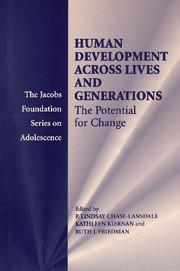Book contents
- Frontmatter
- Contents
- Figures and Tables page
- Contributors
- Foreword
- Acknowledgments
- HUMAN DEVELOPMENT ACROSS LIVES AND GENERATIONS
- Part I Introduction and Overview
- 1 Introduction
- 2 Life-Course Development: The Interplay of Social Selection and Social Causation within and across Generations
- Part II Human Capital
- Part III Partnership Behavior
- Part IV Psychological Health and Development
- Part V Conclusion
- Index
1 - Introduction
from Part I - Introduction and Overview
Published online by Cambridge University Press: 12 October 2018
- Frontmatter
- Contents
- Figures and Tables page
- Contributors
- Foreword
- Acknowledgments
- HUMAN DEVELOPMENT ACROSS LIVES AND GENERATIONS
- Part I Introduction and Overview
- 1 Introduction
- 2 Life-Course Development: The Interplay of Social Selection and Social Causation within and across Generations
- Part II Human Capital
- Part III Partnership Behavior
- Part IV Psychological Health and Development
- Part V Conclusion
- Index
Summary
How much change is possible over a lifetime and across generations? What is realistic in what we can do to promote healthy human development in our nations? These questions captivate societies. They motivate policy makers, teachers, Community leaders, service providers, and advocates as well as researchers. These questions have also motivated our volume.
To answer these questions, one must first define human development. By human development, we mean the ways in which children grow to become healthy, educated, and productive members of societies and nations. Moreover, human development continues throughout adulthood and into old age as adults focus on these same goals as well as provide leadership, inspiration, care, training, and support for the next generation. As illustrated in this volume, we highlight three important dimensions of human development: human capital, partnership behavior, and psychological well-being.
We have chosen these dimensions because they represent widespread goals in society. How can individuals reach their füll potential? Such a goal involves educational attainment and the development of earning power. It also involves the formation, maintenance, and growth of healthy, committed adult partnerships, usually marriage. A third part of this goal is the development of psychological health and the rearing of healthy children who ultimately become successful adult members of society themselves.
The purpose of this volume is also to examine the potential for change across generations and during the life course. We use a multidisciplinary approach to address the three key domains of human development. The volume reviews what is known about these domains in order to develop an integrative and multidisciplinary perspective on promoting positive change across the lifespan.
In the first section, “Human Capital,” authors summarize the economic and social opportunities in European and American households and examine the patterns of transmission of human capital across generations. This section also examines the specific problems of low human capital and social exclusion, as well as the potential for increasing human capital.
The second section, “Partnership Behavior,” summarizes the patterns of family structure in Europe and the United States and examines how partnership behavior influences children, youth, and families. In the third section, “Psychological Health and Development,” authors synthesize what we know about continuity in psychological health and address which environments promote healthy development and how developmental pathways can be changed.
- Type
- Chapter
- Information
- Human Development across Lives and GenerationsThe Potential for Change, pp. 3 - 7Publisher: Cambridge University PressPrint publication year: 2004

